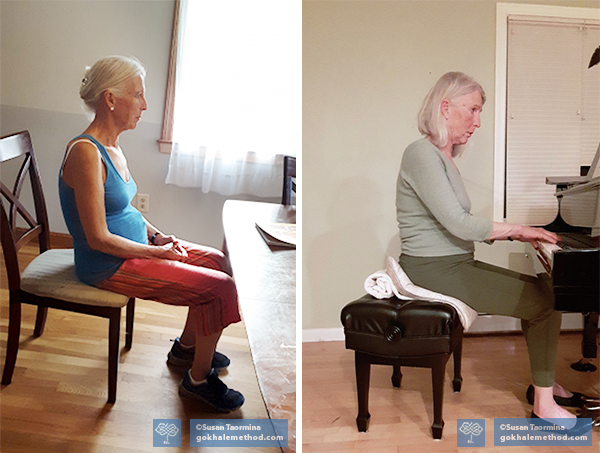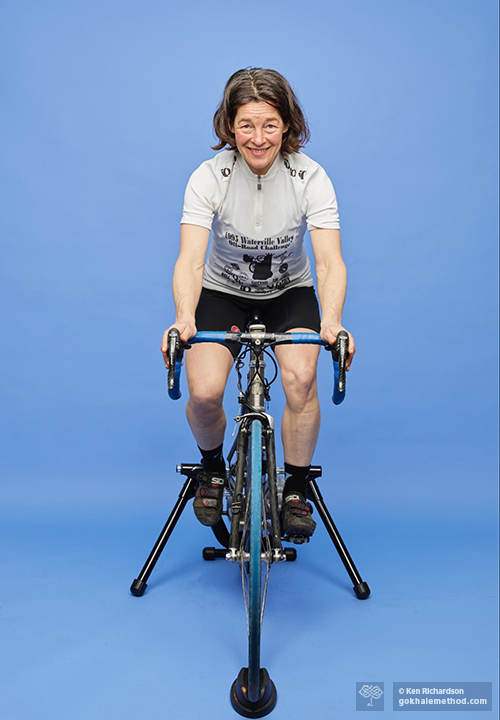Susan’s Success Story
Five Posture Tips to Power Your Cycling
Can the Venus of Willendorf Teach Us about Posture?
Thought to have been made around 30,000 BCE, one of the oldest and most famous prehistoric figurines is known as the Venus of Willendorf. Found in modern-day Austria, this late stone-age artifact is just over 4” high and has traces of ocher coloring. Underneath her ample flesh her pelvis is anteverted, placing her behind behind her. Original image courtesy Wikipedia user MatthiasKabel under CC-BY 2.5.
When the weather is cold and wet, or, for our students in the Southern Hemisphere, hot and dry, museums can be very agreeable places to visit. Humidity and temperature controlled as they are, museums allow you to study posture history in comfort!
A central principle of the Gokhale Method is an
Posture Differences in Elite and Plebeian Ancient Egyptians
This famous bust of Nefertiti (c. 1370 – c. 1330 BC) exhibits a forward-protruded head. Original image courtesy Wikipedia user Philip Pikart under CC-BY-SA 3.0.
In my travels, I enjoy visiting museums. In a concentrated space and in a short few hours, I am able to travel back in time and over large distances, and compare people from different cultures. What a remarkable gift from the craftspeople of the past!
Many museums have a well-developed Egyptian collection. The Egyptians’ expertise in preserving their dead as well as the dry Egyptian climate has yielded a bounty of specimens from the distant past. Egyptian artifacts are often spectacular and modern audiences are drawn to Egyptian
How to Sit on the Floor, Part 1: Cross-legged Sitting
This is the first post in our multi-part series on floor sitting. For Part 2 on squatting, click here.
Sitting cross-legged on the floor is common in many cultures around the world, and has become popular in some segments of modern Western societies.
This Druze woman who I met in Israel has sat cross-legged all her life. She runs a hospitality business — all the food is laid out on the floor and the guests sit along the periphery of the room. She is at ease in this position for extended periods with her back remaining upright and relaxed.
In this temple in Bhubaneswar, devotees sit cross-legged for extended periods in performing rituals.
These Buddha figures in Thailand show relaxed, healthy
How to Play the Guitar with Good Posture
Maintaining healthy posture during the activities you are passionate about is SO important. Good form will allow your body to partake in your favorite activities pain-free now and into the future. It often gives the additional benefit of performing better (because of a steadier hand, improved blood flow,...or just increased comfort and relaxation). We've seen a lot of musicians have to stop playing their instrument due to pain, and able to return to playing after learning the Gokhale Method.
A few months ago, I noticed that Nolan was playing guitar with a tucked pelvis and neck forward and I snapped this photo:
Forward head position puts strain on the neck muscles and threatens the cervical
Fredrik Prost's Journey to Tuva: Posture, Shamanism, and Traditional Life Far Away and Close to Home
Esther's note: Fredrik Prost, the Saami craftsman and posture student I wrote about in these past blogs: Fredrik's Journey to a Pain-Free Back, Sleeping on Birch Branches in Samiland, Beauty, Art, and Posture, and Better Posture, Better Sleep, recently journeyed to Tuva. Here is an account he wrote for us about Tuvan posture, culture, and shamanism, including photos he took. It is a rare treat to hear about indigenous people from an indigenous person - one who speaks English well and knows our posture language too!
Tuva is an autonomous republic of Russia that lies northwest of Mongolia in the south of Siberia.
This summer I went there to explore the Tuvan traditions, in particular their
Working With Scoliosis (Gokhale Method Teacher Cynthia Rose's Back Story)
When I was 12 years old my mother took me to our family doctor for a check up. I remember him looking at me and saying “One of your shoulders slopes down more than the other. Isn’t that interesting!” What’s interesting to me is that the word scoliosis never came up in the conversation and that there wasn’t any further investigation of my sloping shoulder. As a 12-year old I had never heard of scoliosis, so I thought my sloping shoulder was just an oddity I would live with.
It was not until many years later when I returned to school to study massage therapy that I began to notice changes in my spine that manifested as chronic low back pain. I thought it was because of the sitting I was doing
Forward Pelvis: the Good, the Bad, and the Ugly
Opinions on what constitutes a pelvic problem abound. The term "forward pelvis" with its negative connotation, has come to be used for an assortment of pelvic / lumbar architectures, some of which, according to the Gokhale Method - are good, and some bad.
Have you been diagnosed with “forward pelvis” (aka “anterior pelvic tilt”)? If so, you may be concerned about the Gokhale Method recommendation to antevert your pelvis, thinking that this will exacerbate the problem.
Your confusion is not unique. Very few professionals, whether doctors, trainers, or wellness practitioners, differentiate between “forward pelvis / anterior pelvic tilt” and healthy pelvic anteversion. This can lead to poor



